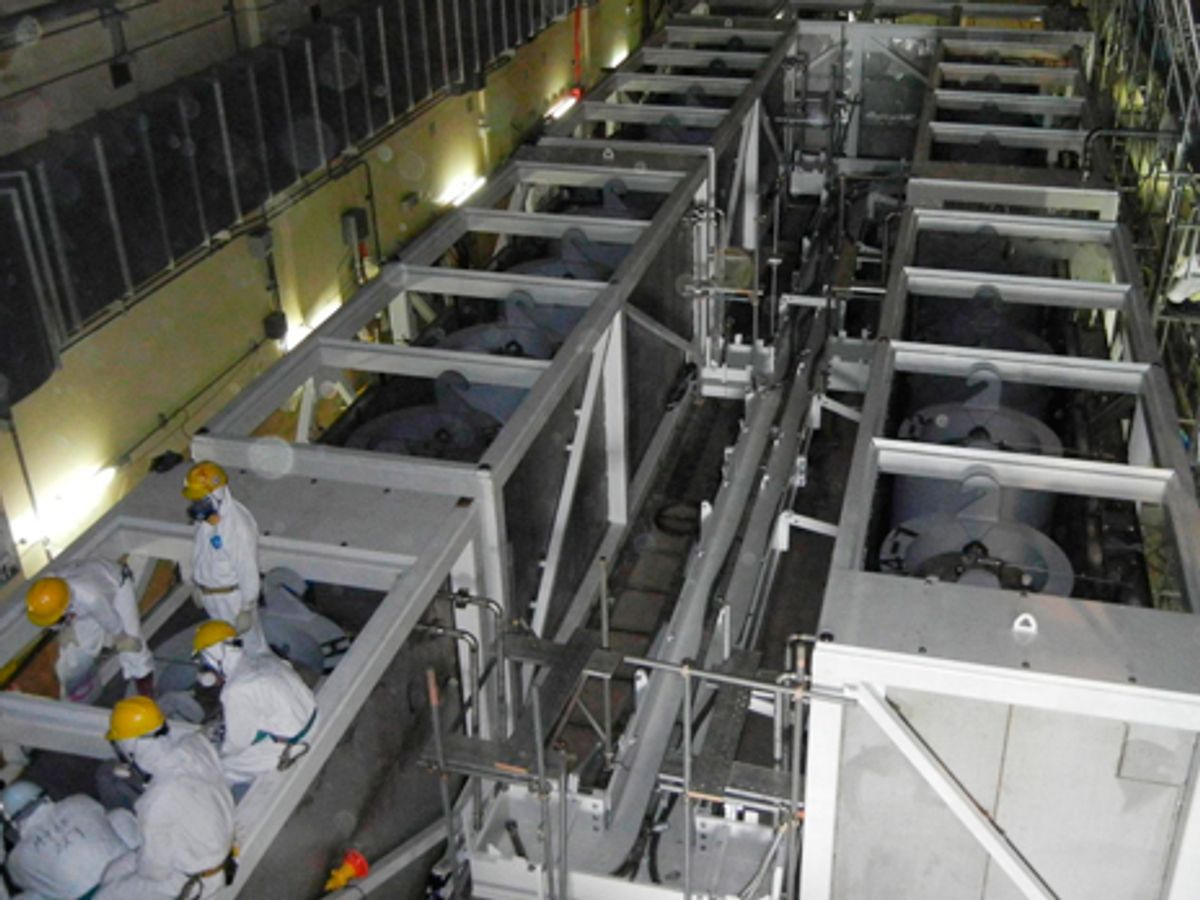Editor's Note: John Boyd is an IEEE Spectrum contributor reporting from Kawasaki, Japan. This is part of IEEE Spectrum's ongoing coverage of Japan's earthquake and nuclear emergency. For more details on how Fukushima Dai-1's nuclear reactors work and what has gone wrong so far, see our explainer and our timeline.
Coping With Radioactive Water
After a number of frustrating setbacks in testing out the water decontamination system, Tokyo Electric Power Co. (TEPCO) finished its latest series of test runs Monday morning, having treated over 6 000 tons of radioactive water stored in the waste water treatment facility. Late Monday afternoon it began full operation of the system, aiming to use the resulting purified water to cool the damaged reactor Units 1, 2 and 3. But operation was once again halted after just 90 minutes when leaks in joints along the 4 km of piping that make up the entire decontamination-cooling system were discovered after water pressure was increased.
A TEPCO official admitted that the piping had not been inspected prior to the start of the operation, as an inspection had been carried out two weeks previously. After repairing the joints, the system was restarted around 2:30 Tuesday afternoon, local time, and no further problems were reported by early Tuesday evening.
Using recycled decontaminated water to cool the reactors is a critical step for several reasons. Until recently, TEPCO has been injecting some 500 tons of pure water daily into the three crippled reactors to prevent them from overheating. But due to structural damage inside the reactors the water becomes contaminated with radioactive elements. That tainted water has been leaking from the reactor systems and pooling in basements and outside trenches, and it is now in danger of overflowing. Establishing a stable cooling system is also regarded as an important milestone in TEPCO’s roadmap to stability, which targets achieving a cold shutdown of the reactors by January.
In addition, once the system is working smoothly, “we will be able to get rid of the stagnant water problem and be able to introduce a larger amount of (pure) water into the reactors to cool the fuel more effectively in the future,” said Hidehiko Nishiyama, Deputy Director-General of the Nuclear and Industrial Safety Agency (NISA) on Monday.
Further Fukushima Developments
Meanwhile, in a port near the nuclear plant TEPCO is assembling a giant frame that holds polyester sheets. After completion and testing, it will be disassembled and carried to the Fukushima Dai-1 site, where it will be reassembled around the No. 1 reactor building with the aim of reducing the amount of radiation entering the atmosphere. If the structure proves effective, similar frames will be assembled around reactor buildings 2 and 3.
Goshi Hosono, the newly appointed minister in charge of the nuclear disaster, said on Tuesday that he hopes it will be possible to reduce the evacuation area around the crippled plant in mid-July and allow some people to return to their homes. He said such a move will occur only when TEPCO establishes a stable cooling system so that there is no longer a risk of a hydrogen explosion, and also reduces radiation levels. Given that radiation levels inside reactor building No. 3 are still high enough to prevent workers from inspecting the situation there, Hosono's July target may be overly optimistic.
TEPCO's Financial Future
In preparing for the trillions of yen it will have to pay out in compensation, TEPCO announced in May that “in principle, domestic/international projects will be sold off, excluding those required for electric power supply.” Last Friday, an ad-hoc panel appointed by the government to oversee the company’s efforts invited TEPCO Chairman Tsunehisa Katsumata to a hearing to discuss the company’s future. Speaking to the press after the session, Katsumata hinted that TEPCO is ready to cut benefits for its employees and retirees should the panel ask it to do so. He also echoed the company’s earlier announcement that it planned to sell off non-core businesses.
More than a decade ago, TEPCO and other regional power companies began a strategy of diversification, when industry critics and academics began calling for the liberalization of the industry. Today, TEPCO is involved in real estate, energy businesses other than electricity, information and telecommunications operations, as well as nursing care services. Together these business segments accounted for 11 percent of its 5 trillion Yen ($53.9 billion) revenues in the fiscal year ending March 2010. This fiscal year the company posted a huge revised loss of 1.34 trillion Yen, more than $16 billion.
Around Japan
The head of the Ministry of Economy, Trade and Industry (METI), Banri Kaieda, has embarked on a diplomatic mission around Japan to convince prefectural governors to restart local nuclear reactors that have been closed down for maintenance inspections. Of Japan’s 54 nuclear reactors, 35 are currently out of operation for maintenance inspections, earthquake-related problems and for other reasons. In the wake of the Fukushima disaster, local residents living in the vicinity of these reactors are concerned over safety, while several prefectural governors have voiced their opposition to resuming operations, despite assurances from the government that the reactors are safe.
Kaieda is arguing that the reactors in question have been inspected and, now that enhanced safety measures have been implemented, are safe to resume operation. He also points out that a shortage of electricity will hamper Japan’s economic recovery.
PHOTO: Reuters/TEPCO





